Abstract
Carbon fiber reinforced polymer laminates are increasingly used in the aerospace and civil engineering fields. Identifying cracks in carbon fiber reinforced polymer laminated beam components is of considerable significance for ensuring the integrity and safety of the whole structures. With the development of high-resolution measurement technologies, mode-shape-based crack identification in such laminated beam components has become an active research focus. Despite its sensitivity to cracks, however, this method is susceptible to noise. To address this deficiency, this study proposes a new concept of multi-resolution modal Teager–Kaiser energy, which is the Teager–Kaiser energy of a mode shape represented in multi-resolution, for identifying cracks in carbon fiber reinforced polymer laminated beams. The efficacy of this concept is analytically demonstrated by identifying cracks in Timoshenko beams with general boundary conditions; and its applicability is validated by diagnosing cracks in a carbon fiber reinforced polymer laminated beam, whose mode shapes are precisely acquired via non-contact measurement using a scanning laser vibrometer. The analytical and experimental results show that multi-resolution modal Teager–Kaiser energy is capable of designating the presence and location of cracks in these beams under noisy environments. This proposed method holds promise for developing crack identification systems for carbon fiber reinforced polymer laminates.
1. Introduction
Carbon fiber reinforced polymer (CFRP) laminates are increasingly utilized in the aerospace and civil engineering fields for their low weight, high strength, and high stiffness [1,2,3]. During the long-term operation of CFRP laminated beam components, such as aircraft wings and wind turbine blades, cracks can occur on their surfaces, jeopardizing the integrity and safety of the whole structures [4,5,6]. Thus, identifying cracks in CFRP laminated beam is of great significance [7,8,9,10,11,12].
Commonly, physical properties such as strain [13,14], electrical resistance [15,16], and eddy current [17,18], can be utilized to identify cracks in CFRP laminates; changes in those physical properties can designate the presence and location of cracks. In contrast, dynamic characters, such as mode shapes, have lower capability to identify cracks in CFRP laminated beams because they are less sensitive to cracks than the aforementioned physical properties [19,20]. To tackle this deficiency, dynamic quantities such as modal curvature and modal strain energy were developed from the mode shape. Pandey et al. [21] proposed the modal curvature, which is the second-order derivative of a mode shape, to represent the crack-caused loss in bending stiffness, whereby cracks in beams can be identified by the change in the modal curvature. The modal curvature method has been further developed by many researchers in the last two decades [22,23,24,25,26,27,28,29,30,31,32,33,34]. The modal strain energy method is another method developed from mode shapes. Cracks can cause changes in modal strain energy, and in turn they can be identified by such changes [32,35,36,37,38,39]; recently, modern signal processing methods such as wavelet transform (WT) [40,41,42,43,44,45,46,47,48,49] and fractal dimension (FD) [50,51,52,53,54] have been applied to mode shapes for crack identification by characterizing the crack-caused singularities therein. Recent attention to crack identification methods relying on mode shape has focused on the robustness of the methods to environmental noise interference [30,33]. To precisely localize cracks, very small spatial sampling intervals matching the width of a crack are required, whereby noise components inevitably involved in densely-sampled mode shapes can cause intense noise interference, masking actual crack-caused changes [55,56]. Hence, developing noise-robust methods relying on mode shapes with the aim of precisely identifying cracks in CFRP laminated beams is the current research interest.
With this concern, this study proposes a physical concept modal Teager–Kaiser energy (M-TKE) derived from the mode shape. The M-TKE is the point-wise energy of a mode shape calculated by the Teager–Kaiser energy (TKE) operator, which features high sensitivity to structural damage. To enhance the noise robustness of the M-TKE, it is transformed to multi-resolution modal Teager–Kaiser energy (MRM-TKE) by the WT-based multi-resolution analysis (MRA) [57,58].
The rest of this paper is organized as follows. Section 2 introduces the fundamental theories of the MRA and the TKE operator. Section 3 proposes the M-TKE based on the TKE operator, and further develops it to the MRM-TKE by the MRA. Section 4 numerically proves the concept of the MRM-TKE to identify cracks in beams. Section 5 experimentally validates the applicability of the MRM-TKE to identification of cracks in CFRP laminated beams, whose modes shapes are precisely acquired via non-contact measurement using a scanning laser vibrometer (SLV). Section 6 presents the conclusions of this study.
2. Fundamental Theories
2.1. MRA
By the theory of the MRA [49,58], an orthonormal, compactly supported wavelet basis of space of measureable, square integral functions is formed by dilating and translating a mother wavelet function :
where and denote sets of real and integer numbers, respectively. satisfies the following two-scale equation:
where is a scaling function that is dilated and translated as
and satisfies the following two-scale equation:
where and denote quadrature mirror filters and have the relationship:
Based on the orthonormal base expressed in Equation (1), the space can be spanned by
Equation (6) implies that the analysis and synthesis of an arbitrary signal in can be, respectively, realized by
Such wavelets provide a framework for the MRA as stated in the following.
Derived from Equation (7), forms a subspace of , leading to
For all , are orthogonal to each other, from which is expressed as
where denotes summing vector spaces. On the other hand, forms a subspace of , which leads to . Thus, in can be represented as
Substituting into Equation (9) results in
Thus, a sequence of closed subspace nested as
forms the MRA of .
Based on the above definitions, a signal in the subspace with the finest resolution can be decomposed into the first to the N-th level:
where is the approximation of at level in , and is the detail of at level in . Equation (13) can be implemented by the discrete wavelet transform (DWT) [43]; the fundamental discrete wavelet, the Haar wavelet, is utilized for the MRA in this study. The scaling function and mother wavelet function of the Haar wavelet are:
whose quadrature mirror filters are
2.2. TKE Operator
The TKE operator was proposed by Kaiser to measure the point-wise energy of a signal [57]. Let be a discretized cosine signal:
where is the amplitude, is the sampling number, is the initial phase, and is the frequency specified by , with being the analog frequency and the sampling frequency. The signal values at three successive points are:
According to the trigonometric identities, the signal values in Equation (17) have the following relationship:
Kaiser found that the left side of Equation (18) can be used to measure the point-wise energy of an oscillating signal, and this nonlinear operator is defined as the TKE operator, denoted [57]:
accordingly, the is called the TKE hereafter in this study.
The TKE operator is sensitive to change in the local frequency and amplitude of a signal [57]. To illustrate this property, consider a frequency-modulated (FM) signal (Figure 1a) and an amplitude-modulated (AM) signal (Figure 1b), whose Teager–Kaiser energies are calculated by Equation (19) and shown in Figure 1c,d, respectively. It can be seen that Teager–Kaiser energy can sensitively reflect changes in local frequency (Figure 1c) and amplitude (Figure 1d) in signals.
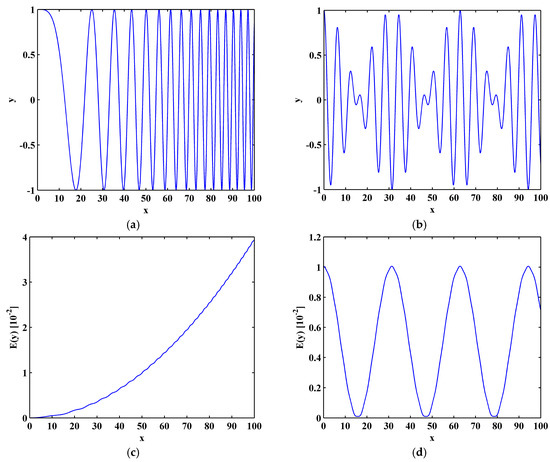
Figure 1.
FM (a) and AM (b) signals; and their respective TKE (c,d).
3. MRM-TKE for Identifying Cracks in Beams under Noisy Environments
This section proposes the M-TKE, from which the MRM-TKE, with stronger robustness to noise interference, is further developed by the WT-based MRA.
3.1. M-TKE
A mode shape of a Timoshenko beam can be expressed as [59]:
where , , , and are unknowns to be solved. and are parameters related to the natural frequency (the higher the natural frequency is, the lager are and ). For a high-order mode shape, Equation (20) can be further written as [60,61]:
where is the beam length. in Equation (21) can be divided into two terms, the decaying term and the steady-state term :
The value of the decaying term exponentially decays from the boundaries at and . The distance from boundaries to the locations where approximates zero is defined as the boundary-effect interval, denoted as . As per Equation (22a), the higher the mode order is, the larger is , and then the smaller are the boundary-effect intervals. Outside the boundary-effect intervals, dominates the high-order mode shape component, contributes little to it. Hence, such high-order mode shape components can be approximately represented as :
where , . The discrete form of in Equation (23) can be written as:
where with being the spatial sampling frequency. The TKE of the mode shape , namely the M-TKE, can be calculated by Equation (17):
By Equation (18), approximates a constant of :
Owing to the sensitivity of the TKE operator to changes in the local frequency and amplitude of signals (shown in Figure 1), the M-TKE can be sensitive to slight changes in and caused by cracks, whereby cracks can be clearly identified by such changes.
3.2. MRM-TKE
Noise components are inevitably involved in measured mode shapes, and Kaiser has proved that the TKE operator is very prone to noise interference [57]; therefore, the vulnerability of the M-TKE to noise interference can hamper its applicability in identifying cracks under noisy environments. To overcome this deficiency, the M-TKE is ameliorated by the WT-based MRA, whereby the MRM-TKE has stronger noise robustness. In accordance with the MRA introduced in Section 2, can be decomposed into the N-th approximation and the first to j-th details () by Equation (13), and the M-TKE can be expressed as:
By discarding the details up to a satisficing level that contain noise components and substituting the retained approximation that contains damage features for in Equation (25), the MRM-TKE is defined, denoted as :
In contrast to the M-TKE with one-fold resolution, the resolution of the MRM-TKE is adjustable by the level , whereby noise components in the M-TKE can be eliminated at a satisficing level in the MRM-TKE; synchronously, crack features in the MRM-TKE can be retained for crack identification. It is worth mentioning that the MRM-TKE method is a non-baseline method, requiring no structural baseline information such as temperature, materials, geometry, and boundary conditions.
4. Proof of Concept
Without loss of generality of the MRM-TKE method, the concept of the MRM-TKE to identify cracks is proven on beams of general materials and boundary conditions with emphasis on its noise robustness.
4.1. Free Vibration of Timoshenko Beams with Cracks
Cracks in a beam are modeled as linear rotational springs with the bending constant of each crack determined by the fracture mechanics principle [62,63]:
where is the Young’s modulus, is the moment of inertia, is the bending constant of the spring, is the beam thickness, is the crack depth ratio with the crack depth, and is the dimensionless local compliance function:
As illustrated in Figure 2, the beam is divided into segments by cracks with each adjacent pair of segments being linked by a crack.

Figure 2.
Analytical model of n-crack beam with n being 3.
According to the theory of Timoshenko beams, governing equations for the flexural vibration of the i-th beam segment are [59]:
where is the transverse deflection; is the slope of deflection due to the bending; and , , , , , and are the Young’s modulus, shear modulus, moment of inertia, material density, cross-sectional area, and the shear coefficient for the cross-section, respectively.
Solutions to Equation (31) consist of spatial and temporal parts:
where is the angular frequency of vibration, is the imaginary unit, and and are the amplitudes of transverse deflection and rotational angle of the i-th beam segment, respectively. Substituting Equation (32) into Equation (31), with the coordinate variables and , geometric and material variables , , , , and , yields the equations [64]:
Let , , , , the solutions of and can be expressed as [65,66,67]:
Compatible conditions of displacement, slope, moment, and shear force in the crack locations can be expressed as [67]:
Without loss of generality, boundaries at each end of the beam are simulated by a pair of linear springs, by which the boundary conditions at each end can be expressed as [68]:
where and are constants of springs providing translational and rotational restraints, respectively. Equation (36) can be further written as [68]:
where parameters and . According to Equation (37), four common boundary conditions can be represented: for a simply supported (SS) end, and produce boundary conditions with and ; for a free (F) end, and produce boundary conditions with and ; for a free-shear (FS) end, and produce boundary conditions with and ; and for a clamped (C) end, and produce boundary conditions with and .
Substituting Equation (34) into the four equations of boundary conditions at the two ends and equations of compatible conditions at the crack locations, a group of simultaneous equations with respect to can be obtained:
where is a column vector of , , and (), and is a matrix. To achieve nontrivial solutions, the determinant of , , is set to zero to produce the frequency equation:
Solving Equation (39) produces a sequence of natural frequencies [69]; provided with , the corresponding coefficient vector can be derived from Equation (38); substituting and into Equation (34a), the m-th mode shape can be obtained.
4.2. Crack Identification
A general beam with the dimensions of length 500 mm, width 30 mm, and depth 10 mm is taken as a specimen. Three cracks are introduced at locations x = 125 mm (), 275 mm (), and 375 mm (), with depths of 2.5 mm (), 2 mm (), and 3 mm (), respectively. Three scenarios associated with three common types of boundary conditions are considered: SS-SS, C-F, and C-SF boundary conditions for the sixth, seventh, and eighth modes, respectively.
The sixth, seventh and eighth sampled mode shapes associated with the SS-SS, C-F, and C-FS boundary conditions (Figure 3) are produced following the procedure given in Section 4.1 with 501 uniformly distributed sampling points. The corresponding M-TKE is obtained by Equation (25), and shown in Figure 4 with values in boundary-effect interval () vanished. It can be seen in Figure 4a,b that three peaks in evidently indicate the presence of three cracks and clearly pinpoint the cracks at , 0.55, and 0.75, which correspond to the actual crack locations , , and ; in Figure 4c, only two peaks appear at and because the location of the second crack at is close to one of the nodes, and it is hard to identify such cracks because vibration near a node is always of close-to-zero amplitude [27,70]. Thus, under a noise-free environment, the M-TKE is capable of identifying cracks in beams. For actually measured mode shapes, however, noise components are inevitably incorporated. To simulate a normal noisy environment, white Gaussian noise is added to the to produce noisy mode shapes of 60 dB signal-to-noise ratio (SNR) [33]; the lower the SNR is, the noisier is the mode shape. The corresponding noise-contaminated is obtained and shown in Figure 5, where intense noise interference considerably masks crack-caused peaks in the . Thus, susceptibility to noise severely hampers the capability of the M-TKE to identify cracks in beams under noisy environments.

Figure 3.
(a) Sixth; (b) seventh; and (c) eighth mode shapes of SS-SS, C-F, and C-FS beams.

Figure 4.
M-TKE for the (a) sixth; (b) seventh; and (c) eighth noise-free mode shapes.

Figure 5.
M-TKE for the (a) sixth; (b) seventh; and (c) eighth mode shapes with 60 dB SNR.
To eliminate noise interference, the second-level () approximations are extracted from the mode shapes by Equation (13), as shown in Figure 6; then the MRM-TKE is obtained by Equation (28), as shown in Figure 7 with values in the boundary-effect interval () vanished. It can be seen from Figure 7 that noise interference is basically eliminated and crack-caused peaks can be clearly identified. In Figure 7a,b, three damage-induced peaks stand out obviously and clearly pinpoint the cracks at , 0.55, and 0.75, which correspond to the actual crack locations , , and ; in Figure 7c only two peaks appear at and because of the node effect mentioned before. Thus, demonstrably superior to the M-TKE, the MRM-TKE features much stronger robustness to noise interference and is capable of identifying cracks in beams under noisy environments.

Figure 6.
The second-level approximations of the (a) sixth; (b) seventh; and (c) eighth mode shapes with 60 dB SNR.

Figure 7.
MRM-TKE for the (a) sixth; (b) seventh; and (c) eighth mode shapes with 60 dB SNR.
4.3. Noise Tolerance
To demonstrate the noise tolerance of the MRM-TKE, a broader range of noise levels with decreasing SNRs of 55 dB, 50 dB, and 45 dB are considered; the corresponding results are shown in Figure 8, Figure 9 and Figure 10, respectively. At the noise level of 55 dB SNR, the MRM-TKE appears slightly noisier than the results for the 60 dB SNR (Figure 7), and the crack-caused peaks can still clearly identify the three cracks in the SS-SS beam and the C-F beam (Figure 8a,b), and the first and the third cracks in the C-FS beam (Figure 8c); at the noise level of 50 dB SNR, noise interference becomes more intense, but peaks can be still identified (Figure 9) by increasing the level of the approximation to ; at the noise level of 45 dB SNR, noise interference becomes severe, and peaks are just distinguishable (Figure 10) when the level of the approximation is further increased to . Thus, noise level of 45 dB SNR can be regarded as the limit of the noise tolerance of the MRM-TKE for the given scenarios.

Figure 8.
MRM-TKE for the (a) sixth; (b) seventh; and (c) eighth mode shapes with 55 dB SNR.

Figure 9.
MRM-TKE for the (a) sixth; (b) seventh; and (c) eighth mode shapes with 50 dB SNR.

Figure 10.
MRM-TKE for the (a) sixth; (b) seventh; and (c) eighth mode shapes with 45 dB SNR.
Modal curvature method [21], one of the most commonly used methods for crack identification in beams, is employed for comparison. Modal curvatures at the limit noise level of 45 dB are shown in Figure 11. It can be seen in Figure 11 that similar to the results of the M-TKE (Figure 5), damage features can be barely identified due to intense noise interference. Thus, MRM-TKE features stronger noise robustness than the commonly utilized modal curvature for crack identification in beams.

Figure 11.
Modal curvatures for the (a) sixth; (b) seventh; and (c) eighth mode shapes with 45 dB SNR.
5. Experimental Validation
The applicability of the MRM-TKE to the identification of cracks is experimentally validated on a CFRP laminated beam, whose modes shapes are acquired via non-contact measurement using a SLV.
5.1. Setup
A CFRP laminated beam of length 500 mm, width 10 mm, and depth 1.5 mm, consisting of five plies each 0.3 mm in thickness, is taken as an experimental specimen. The dimensions of the beam are shown in Figure 12 in millimeters. As shown in Figure 12, the beam is clamped at the left end with the fixing area spanning 10 mm from the left edge. Four damage scenarios, Scenarios I, II, III and IV, are considered. First, three through-width cracks are manufactured in the first two plies on the surface, about 0.5 mm () in depth between the first and the second plies. In Scenario I, the fourth mode is considered; in Scenario II, the fifth mode is considered. Then, all three cracks are increased to about 0.9 mm () in depth through the third ply. In Scenario III, the fourth mode is considered and, in Scenario IV, the fifth mode is considered. The first, second, and third cracks, indicated by dashed lines in Figure 12, occur at locations 113 mm, 221 mm, and 365 mm from the left edge, respectively.
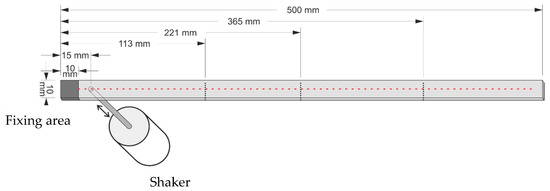
Figure 12.
Dimensions in millimeters of cracked beam with shaker and measurement points.
A vibration shaker (4809, B&K, Nærum, Denmark), attached to the cracked side of the beam, 15 mm from its left edge, acts as an actuator to excite the beam. When the beam vibrates under harmonic excitation at the fourth natural frequency of 241.79 Hz, the SLV (PSV-400, Polytec, Waldbronn, Germany) is used as a sensor to scan the intact side of the beam to acquire the operating deflection shape (ODS), that can be regarded as the fourth mode shape for this lightly-damped beam [71]. The SLV scans over 499 measurement points uniformly distributed on the intact surface, 10 mm through 496 mm from the left edge; the dimensionless locations for the first, second, and third cracks in the scanning length are , , and , respectively. Figure 13 shows the experimental setup including the SLV and the shaker along with a zoomed-in view of the crack in the CFRP laminated beam.
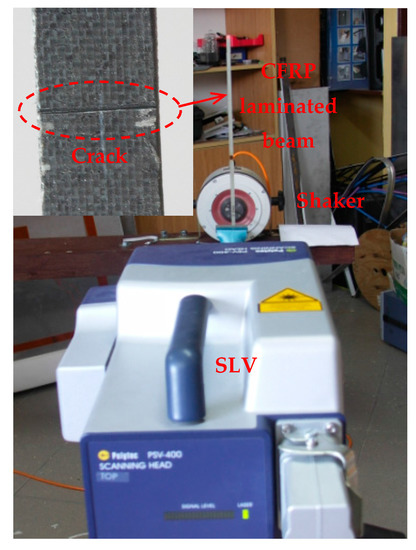
Figure 13.
Experimental setup.
5.2. Experimental Results
In Scenario I, the fourth mode shape is shown in Figure 14a, from which the M-TKE is obtained by Equation (25) and is shown in Figure 14b. In Figure 14b, damage features of can be barely identified due to intense noise interference. The second-level () approximation is obtained by Equation (13), and is shown in Figure 15a, from which the MRM-TKE is obtained by Equation (28) and is shown in Figure 15b, where three crack-caused peaks stand out obviously, clearly pinpointing three cracks at about , , and , agreeing well with the actual locations of the first, second, and third cracks.
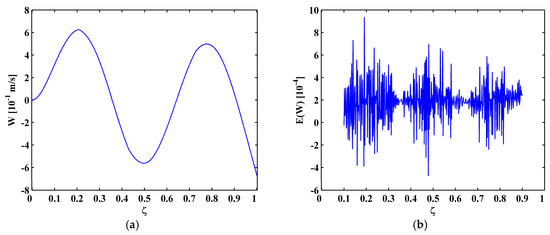
Figure 14.
The fourth mode shape (a) and M-TKE (b) for Scenario I.
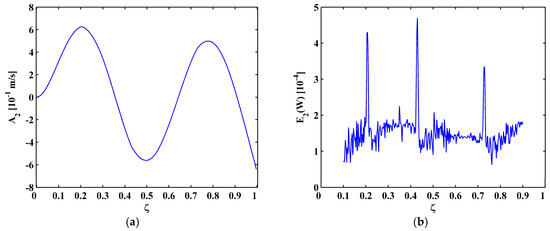
Figure 15.
Second-level approximation of the fourth mode shape (a) and MRM-TKE (b) for Scenario I.
The results of the experiment validate the contention that the M-TKE lacks noise robustness, whereas the MRM-TKE is robust to noise interference, capable of designating the presence and location of cracks in CFRP laminated beams under noisy environments. Modal curvature for Scenario I is shown in Figure 16 for comparison. It can be seen in Figure 16 that, similar to the analytical results in Figure 11, damage features can be barely identified due to intense noise interference.
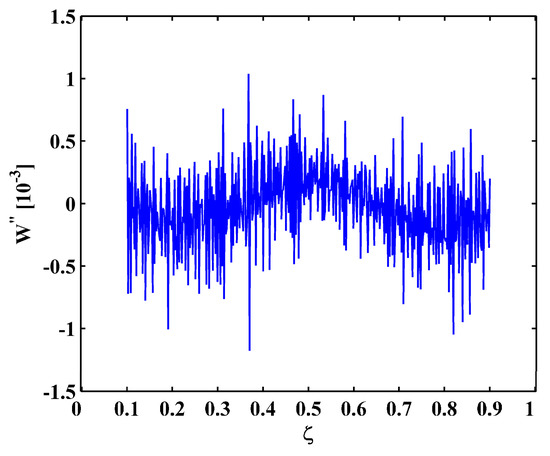
Figure 16.
Modal curvature for Scenario I.
For Scenarios II, the fifth mode shape is shown in Figure 17a, and the corresponding MRM-TKE is shown in Figure 17b. In Figure 17b, only two peaks appear at and , because the third crack at is close to one of the nodes. The reason has been given in Section 4.2 that vibration close to a node is always of close-to-zero amplitude. For Scenarios III and IV with deeper cracks, crack-caused peaks are of larger amplitudes and more evident, which is more beneficial to crack identification. For Scenario III, three peaks clearly identify all three cracks (Figure 18a); and, for Scenario IV, only the first and third cracks can be identified (Figure 18b).
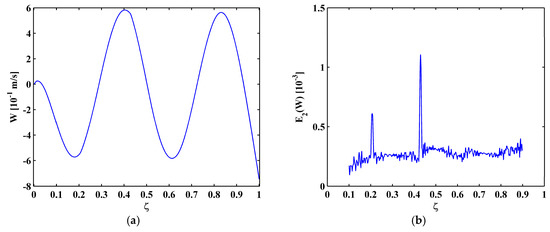
Figure 17.
The fifth mode shape (a) and MRM-TKE (b) for Scenario II.
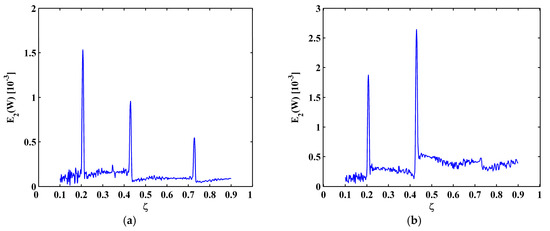
Figure 18.
MRM-TKE for Scenario III (a) and Scenario IV (b).
It can be seen from the MRM-TKE for Scenarios I to IV that deeper cracks are more evident to be identified by the MRM-TKE because the peak of the MRM-TKE increases with crack depth; cracks close to nodes are hard to identify because of the node effect. In addition, when smaller depths of cracks, e.g., 0.25 mm, are considered, the peaks in the MRM-TKE become less prominent.
6. Conclusions
To identify cracks in CFRP laminated beams under noisy environments, this study proposes a physical concept M-TKE derived from a mode shape, that is sensitive to crack-caused changes in the local frequency and amplitude. To enhance the noise robustness of the M-TKE, it is transformed to the MRM-TKE by the WT-based MRA. The efficacy of this concept is analytically demonstrated by identifying cracks in Timoshenko beams with general boundary conditions; and its applicability is validated in a CFRP laminated beam, whose mode shapes are precisely acquired via non-contact measurement using a SLV. The analytical and experimental results show that the MRM-TKE is capable of designating the presence and location of cracks in CFRP laminated beams under noisy environments. Some conclusions are drawn below:
- Cracks can cause rapid changes in the M-TKE because the TKE operator is sensitive to slight changes in the local frequency and amplitude of a mode shape. However, the M-TKE is very prone to noise interference and therefore lacks the robustness to identify cracks under noise environments.
- To enhance the noise robustness of the M-TKE, the MRM-TKE is developed from the M-TKE with the WT-based MRA, whereby noise components in the M-TKE can be eliminated at a satisficing level in the MRM-TKE; synchronously, damage-caused change in the M-TKE can be retained in the MRM-TKE. Thus, the MRM-TKE is capable of identifying cracks in CFRP laminated beams under noisy environments.
- The MRM-TKE method is a non-baseline method, requiring no structural baseline information such as temperature, materials, geometry, and boundary conditions. The only requirement for the MRM-TKE method is that high-order modes are needed for small boundary-effect intervals.
Acknowledgments
The authors are grateful for the partial support provided by the China Postdoctoral Science Foundation (No. 2017M610289), the Natural Science Foundation of China (No. 51508156) and the Qing Lan Project of Jiangsu Province (No. 2014035).
Author Contributions
Maosen Cao and Keqin Ding conceived the method; Wei Xu actualized the algorithm and wrote the paper; Wiesław Ostachowicz and Maciej Radzieński contributed materials and conducted the experiment.
Conflicts of Interest
The authors declare no conflict of interest.
References
- Mohee, F.M.; Al-Mayah, A.; Plumtree, A. Anchors for CFRP plates: State-of-the-art review and future potential. Compos. Part B-Eng. 2016, 90, 432–442. [Google Scholar] [CrossRef]
- Xie, X.; Li, X.; Shen, Y. Static and dynamic characteristics of a long-span cable-stayed bridge with CFRP cables. Materials 2014, 7, 4854–4877. [Google Scholar] [CrossRef]
- Prakash, R.; Krishnaraj, V.; Zitoune, R.; Sheikh-Ahmad, J. High-speed edge trimming of CFRP and online monitoring of performance of router tools using acoustic emission. Materials 2016, 9, 798. [Google Scholar] [CrossRef]
- Jeong, Y.; Lee, J.; Kim, W. Modeling and measurement of sustained loading and temperature-dependent deformation of carbon fiber-reinforced polymer bonded to concrete. Materials 2015, 8, 435–450. [Google Scholar] [CrossRef]
- Maier, A.; Schmidt, R.; Oswald-Tranta, B.; Schledjewski, R. Non-destructive thermography analysis of impact damage on large-scale CFRP automotive parts. Materials 2014, 7, 413–429. [Google Scholar] [CrossRef]
- Zuluaga-Ramírez, P.; Frövel, M.; Belenguer, T.; Salazar, F. Surface irregularity factor as a parameter to evaluate the fatigue damage state of CFRP. Materials 2015, 8, 7524–7535. [Google Scholar] [CrossRef]
- Yuan, S.; Bao, Q.; Qiu, L.; Zhong, Y. A single frequency component-based re-estimated MUSIC algorithm for impact localization on complex composite structures. Smart Mater. Struct. 2015, 24, 105021. [Google Scholar] [CrossRef]
- Qiu, L.; Yuan, S.; Bao, Q.; Mei, H.; Ren, Y. Crack propagation monitoring in a full-scale aircraft fatigue test based on guided wave-Gaussian mixture model. Smart Mater. Struct. 2016, 25, 055048. [Google Scholar] [CrossRef]
- Giurgiutiu, V.; Yu, L.; Kendall, J.R.I.; Jenkins, C. In situ imaging of crack growth with piezoelectric-wafer active sensors. AIAA J. 2007, 45, 2758–2769. [Google Scholar] [CrossRef]
- Lam, H.F.; Yin, T. Application of two-dimensional spatial wavelet transform in the detection of an obstructed crack on a thin plate. Struct. Control Health Monit. 2012, 19, 260–277. [Google Scholar] [CrossRef]
- Liu, P.; Sohn, H.; Kundu, T.; Yang, S. Noncontact detection of fatigue cracks by laser nonlinear wave modulation spectroscopy (LNWMS). NDT E Int. 2014, 66, 106–116. [Google Scholar] [CrossRef]
- Parvasi, S.M.; Xu, C.; Kong, Q.; Song, G. Detection of multiple thin surface cracks using vibrothermography with low-power piezoceramic-based ultrasonic actuator—A numerical study with experimental verification. Smart Mater. Struct. 2016, 25, 055042. [Google Scholar] [CrossRef]
- Okabe, Y.; Tanaka, N.; Takeda, N. Effect of fiber coating on crack detection in carbon fiber reinforced plastic composites using fiber Bragg grating sensors. Smart Mater. Struct. 2002, 11, 892–898. [Google Scholar] [CrossRef]
- Aratama, S.; Hashizume, R.; Takenaka, K.; Koga, K.; Tsumura, Y.; Miyake, T.; Nishikawa, M.; Hojo, M. Microscopic observation of voids and transverse crack initiation in CFRP laminates. Adv. Compos. Mater. 2016, 25, 115–130. [Google Scholar] [CrossRef]
- Matsuzaki, R.; Todoroki, A. Wireless detection of internal delamination cracks in CFRP laminates using oscillating frequency changes. Compos. Sci. Technol. 2006, 66, 407–416. [Google Scholar] [CrossRef]
- Todoroki, A.; Omagari, K.; Shimamura, Y.; Kobayashi, H. Matrix crack detection of CFRP using electrical resistance change with integrated surface probes. Compos. Sci. Technol. 2006, 66, 1539–1545. [Google Scholar] [CrossRef]
- Cheng, L.; Tian, G.Y. Surface crack detection for carbon fiber reinforced plastic (CFRP) materials using pulsed eddy current thermography. IEEE Sens. J. 2011, 11, 3261–3268. [Google Scholar] [CrossRef]
- Wu, J.; Zhou, D.; Wang, J. Surface crack detection for carbon fiber reinforced plastic materials using pulsed eddy current based on rectangular differential probe. J. Sens. 2014, 2014, 727269. [Google Scholar] [CrossRef]
- Fan, W.; Qiao, P. Vibration-based damage identification methods: A review and comparative study. Struct. Health Monit. 2011, 10, 83–111. [Google Scholar] [CrossRef]
- Cao, M.S.; Ostachowicz, W.; Radzienski, M.; Xu, W. Multiscale shear-strain gradient for detecting delamination in composite laminates. Appl. Phys. Lett. 2013, 103, 101910. [Google Scholar] [CrossRef]
- Pandey, A.K.; Biswas, M.; Samman, M.M. Damage detection from changes in curvature mode shapes. J. Sound Vib. 1991, 145, 321–332. [Google Scholar] [CrossRef]
- Ratcliffe, C.P.; Bagaria, W.J. Vibration technique for locating delamination in a composite beam. AIAA J. 1998, 36, 1074–1077. [Google Scholar] [CrossRef]
- Abdel Wahab, M.M.; De Roeck, G. Damage detection in bridges using modal curvatures: Application to a real damage scenario. J. Sound Vib. 1999, 226, 217–235. [Google Scholar] [CrossRef]
- Ratcliffe, C.P. A frequency and curvature based experimental method for locating damage in structures. J. Vib. Acoust. 2000, 122, 324–329. [Google Scholar] [CrossRef]
- Hu, N.; Fukunaga, H.; Kameyama, M.; Aramaki, Y.; Chang, F.K. Vibration analysis of delaminated composite beams and plates using a higher-order finite element. Int. J. Mech. Sci. 2002, 44, 1479–1503. [Google Scholar] [CrossRef]
- Hamey, C.S.; Lestari, W.; Qiao, P.Z.; Song, G.B. Experimental damage identification of carbon/epoxy composite beams using curvature mode shapes. Struct. Health Monit. 2004, 3, 333–353. [Google Scholar] [CrossRef]
- Lestari, W.; Qiao, P.; Hanagud, S. Curvature mode shape-based damage assessment of carbon/epoxy composite beams. J. Intell. Mater. Syst. Struct. 2007, 18, 189–208. [Google Scholar] [CrossRef]
- Cao, M.; Qiao, P. Novel Laplacian scheme and multiresolution modal curvatures for structural damage identification. Mech. Syst. Signal Process. 2009, 23, 1223–1242. [Google Scholar] [CrossRef]
- Sung, S.H.; Jung, H.J.; Jung, H.Y. Damage detection for beam-like structures using the normalized curvature of a uniform load surface. J. Sound Vib. 2013, 332, 1501–1519. [Google Scholar] [CrossRef]
- Cao, M.; Radzienski, M.; Xu, W.; Ostachowicz, W. Identification of multiple damage in beams based on robust curvature mode shapes. Mech. Syst. Signal Process. 2014, 46, 468–480. [Google Scholar] [CrossRef]
- Cao, M.; Xu, W.; Ostachowicz, W.; Su, Z. Damage identification for beams in noisy conditions based on Teager energy operator-wavelet transform modal curvature. J. Sound Vib. 2014, 333, 1543–1553. [Google Scholar] [CrossRef]
- Sazonov, E.; Klinkhachorn, P. Optimal spatial sampling interval for damage detection by curvature or strain energy mode shapes. J. Sound Vib. 2005, 285, 783–801. [Google Scholar] [CrossRef]
- Cao, M.; Xu, W.; Ren, W.; Ostachowicz, W.; Sha, G.; Pan, L. A concept of complex-wavelet modal curvature for detecting multiple cracks in beams under noisy conditions. Mech. Syst. Signal Process. 2016, 76, 555–575. [Google Scholar] [CrossRef]
- Yang, Z.; Radzienski, M.; Kudela, P.; Ostachowicz, W. Fourier spectral-based modal curvature analysis and its application to damage detection in beams. Mech. Syst. Signal Process. 2017, 84, 763–781. [Google Scholar] [CrossRef]
- Li, Y.Y.; Cheng, L.; Yam, L.H.; Wong, W.O. Identification of damage locations for plate-like structures using damage sensitive indices: Strain modal approach. Comput. Struct. 2002, 80, 1881–1894. [Google Scholar] [CrossRef]
- Stubbs, N.; Kim, J.T. Damage localization in structures without baseline modal parameters. AIAA J. 1996, 34, 1644–1649. [Google Scholar] [CrossRef]
- Law, S.S.; Shi, Z.Y.; Zhang, L.M. Structural damage detection from incomplete and noisy modal test data. J. Eng. Mech. 1998, 124, 1280–1288. [Google Scholar] [CrossRef]
- Cornwell, P.; Doebling, S.W.; Farrar, C.R. Application of the strain energy damage detection method to platelike structures. J. Sound Vib. 1999, 224, 359–374. [Google Scholar] [CrossRef]
- Shi, Z.Y.; Law, S.S.; Zhang, L.M. Structural damage detection from modal strain energy change. J. Eng. Mech. 2000, 126, 1216–1223. [Google Scholar] [CrossRef]
- Rucka, M.; Wilde, K. Crack identification using wavelets on experimental static deflection profiles. Eng. Struct. 2006, 28, 279–288. [Google Scholar] [CrossRef]
- Mallat, S.; Hwang, W.L. Singularity detection and processing with wavelets. IEEE Trans. Inf. Theory 1992, 38, 617–643. [Google Scholar] [CrossRef]
- Liew, K.M.; Wang, Q. Application of wavelet theory for crack identification in structures. J. Eng. Mech. 1998, 124, 152–157. [Google Scholar] [CrossRef]
- Wang, Q.; Deng, X.M. Damage detection with spatial wavelets. Int. J. Solids Struct. 1999, 36, 3443–3468. [Google Scholar] [CrossRef]
- Hong, J.C.; Kim, Y.Y.; Lee, H.C.; Lee, Y.W. Damage detection using the Lipschitz exponent estimated by the wavelet transform: Applications to vibration modes of a beam. Int. J. Solids Struct. 2002, 39, 1803–1816. [Google Scholar] [CrossRef]
- Douka, E.; Loutridis, S.; Trochidis, A. Crack identification in beams using wavelet analysis. Int. J. Solids Struct. 2003, 40, 3557–3569. [Google Scholar] [CrossRef]
- Kim, H.S.; Melhem, H. Damage detection of structures by wavelet analysis. Eng. Struct. 2004, 26, 347–362. [Google Scholar] [CrossRef]
- Chang, C.C.; Chen, L.W. Damage detection of a rectangular plate by spatial wavelet based approach. Appl. Acoust. 2004, 65, 819–832. [Google Scholar] [CrossRef]
- Rucka, M.; Wilde, K. Application of continuous wavelet transform in vibration based damage detection method for beams and plates. J. Sound Vib. 2006, 297, 536–550. [Google Scholar] [CrossRef]
- Cao, M.; Qiao, P. Integrated wavelet transform and its application to vibration mode shapes for the damage detection of beam-type structures. Smart Mater. Struct. 2008, 17, 055014. [Google Scholar] [CrossRef]
- Hadjileontiadis, L.J.; Douka, E.; Trochidis, A. Fractal dimension analysis for crack identification in beam structures. Mech. Syst. Signal Process. 2005, 19, 659–674. [Google Scholar] [CrossRef]
- Wang, J.; Qiao, P. Improved damage detection for beam-type structures using a uniform load surface. Struct. Health Monit. 2007, 6, 99–110. [Google Scholar] [CrossRef]
- Qiao, P.; Cao, M. Waveform fractal dimension for mode shape-based damage identification of beam-type structures. Int. J. Solids Struct. 2008, 45, 5946–5961. [Google Scholar] [CrossRef]
- Bai, R.; Cao, M.; Su, Z.; Ostachowicz, W.; Xu, H. Fractal dimension analysis of higher-order mode shapes for damage identification of beam structures. Math. Probl. Eng. 2012, 2012, 454568. [Google Scholar] [CrossRef]
- Bai, R.B.; Ostachowicz, W.; Cao, M.S.; Su, Z. Crack detection in beams in noisy conditions using scale fractal dimension analysis of mode shapes. Smart Mater. Struct. 2014, 23, 065014. [Google Scholar] [CrossRef]
- Xu, W.; Cao, M.S.; Radzienski, M.; Xia, N.; Su, Z.; Ostachowicz, W.; Wang, S.S. Detecting multiple small-sized damage in beam-type structures by Teager energy of modal curvature shape. J. Vibroeng. 2015, 17, 275–286. [Google Scholar]
- Montanari, L.; Spagnoli, A.; Basu, B.; Broderick, B. On the effect of spatial sampling in damage detection of cracked beams by continuous wavelet transform. J. Sound Vib. 2015, 345, 233–249. [Google Scholar] [CrossRef]
- Kaiser, J.F. On a simple algoritm to calculate the energy of a signal. In Proceedings of the Acoustics, Speech and Signal Processing, Albuquerque, NM, USA, 3–6 April 1990. [Google Scholar]
- Mallat, S.G. A theory for multiresolution signal decomposition: The wavelet representation. IEEE Trans. Pattern Anal. 1989, 11, 674–693. [Google Scholar] [CrossRef]
- Timoshenko, S.P.X. On the transverse vibrations of bars of uniform cross-section. Philos. Mag. 1922, 43, 125–131. [Google Scholar] [CrossRef]
- Dugundji, J. Simple expressions for higher vibration modes of uniform Euler beams. AIAA J. 1988, 26, 1013–1014. [Google Scholar] [CrossRef]
- Pai, P.F.; Young, L.G. Damage detection of beams using operational deflection shapes. Int. J. Solids Struct. 2001, 38, 3161–3192. [Google Scholar] [CrossRef]
- Rizos, P.F.; Aspragathos, N.; Dimarogonas, A.D. Identification of crack location and magnitude in a cantilever beam from the vibration modes. J. Sound Vib. 1990, 138, 381–388. [Google Scholar] [CrossRef]
- Ostachowicz, W.M.; Krawczuk, M. Analysis of the effect of cracks on the natural frequencies of a cantilever beam. J. Sound Vib. 1991, 150, 191–201. [Google Scholar] [CrossRef]
- Huang, T.C. The effect of rotatory inertia and of shear deformation on the frequency and normal mode equations of uniform beams with simple end conditions. J. Appl. Mech. 1961, 28, 579–584. [Google Scholar] [CrossRef]
- Lin, H.P. Direct and inverse methods on free vibration analysis of simply supported beams with a crack. Eng. Struct. 2004, 26, 427–436. [Google Scholar] [CrossRef]
- Greco, A.; Pau, A. Damage identification in Euler frames. Comput. Struct. 2012, 92–93, 328–336. [Google Scholar] [CrossRef]
- Khaji, N.; Shafiei, M.; Jalalpour, M. Closed-form solutions for crack detection problem of Timoshenko beams with various boundary conditions. Int. J. Mech. Sci. 2009, 51, 667–681. [Google Scholar] [CrossRef]
- Abbas, B. Vibrations of Timoshenko beams with elastically restrained ends. J. Sound Vib. 1984, 97, 541–548. [Google Scholar] [CrossRef]
- Cao, M.S.; Xu, W.; Su, Z.; Ostachowicz, W.; Xia, N. Local coordinate systems-based method to analyze high-order modes of n-step Timoshenko beam. J. Vib. Control 2017, 23, 89–102. [Google Scholar] [CrossRef]
- Xu, W.; Zhu, W.D.; Smith, S.A.; Cao, M.S. Structural damage detection using slopes of longitudinal vibration shapes. J. Vib. Acoust. 2016, 138, 034501. [Google Scholar] [CrossRef]
- Schwarz, B.J.; Richardson, M.H. Introduction to Operating Deflection Shapes; CSI Reliability Week: Orlando, FL, USA, 1999; Volume 10, pp. 121–126. [Google Scholar]
© 2017 by the authors. Licensee MDPI, Basel, Switzerland. This article is an open access article distributed under the terms and conditions of the Creative Commons Attribution (CC BY) license (http://creativecommons.org/licenses/by/4.0/).